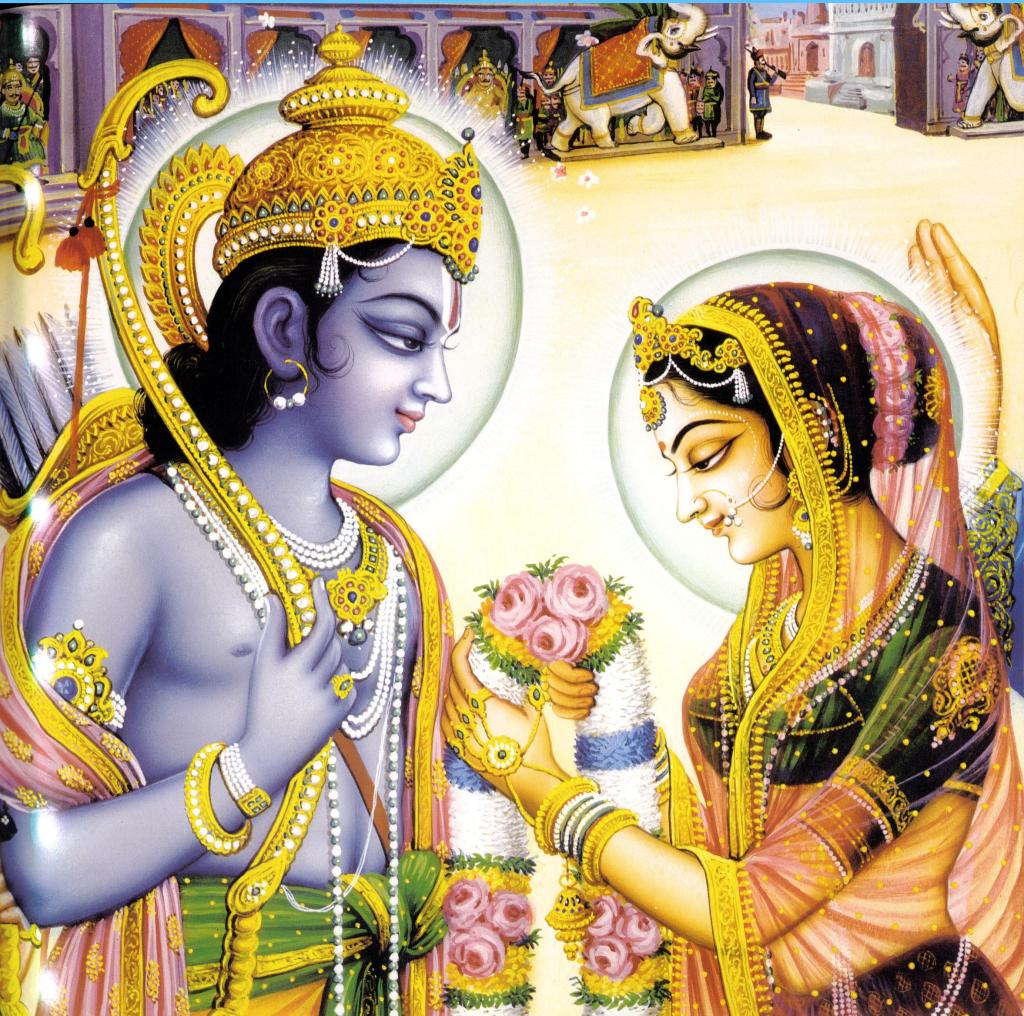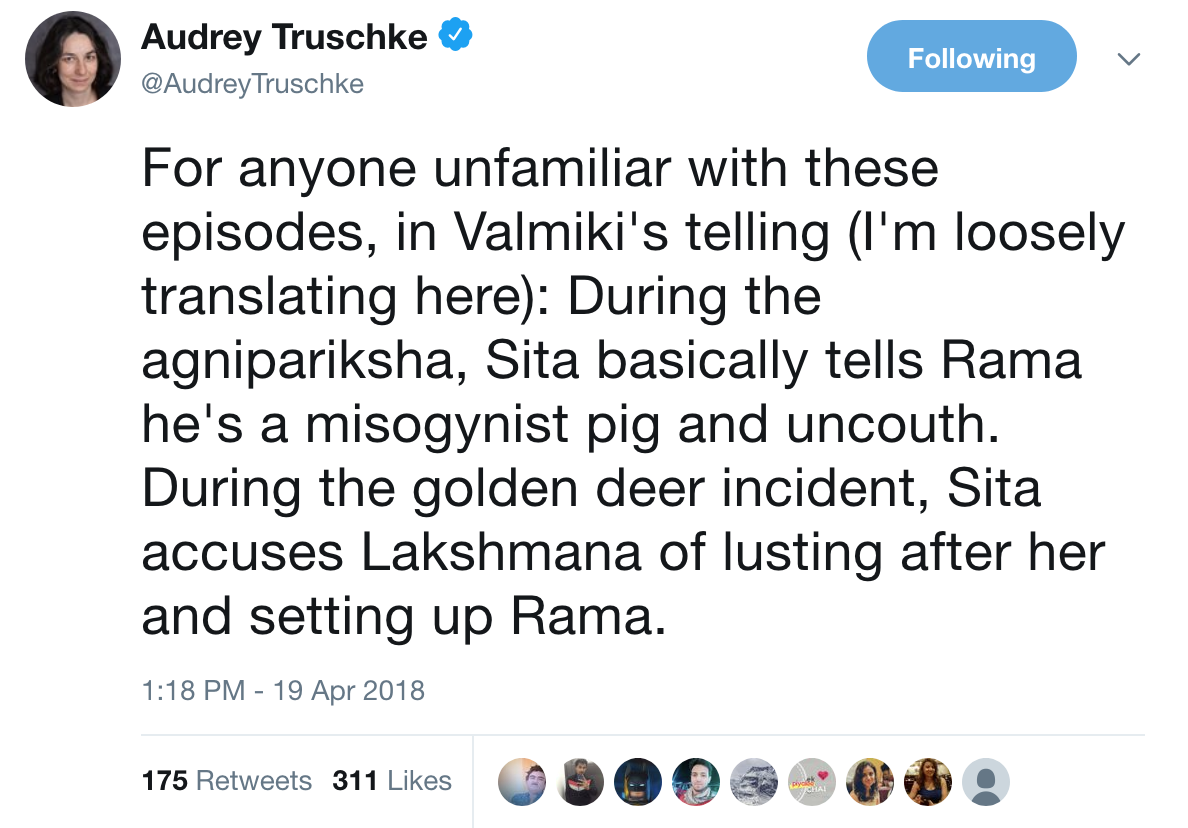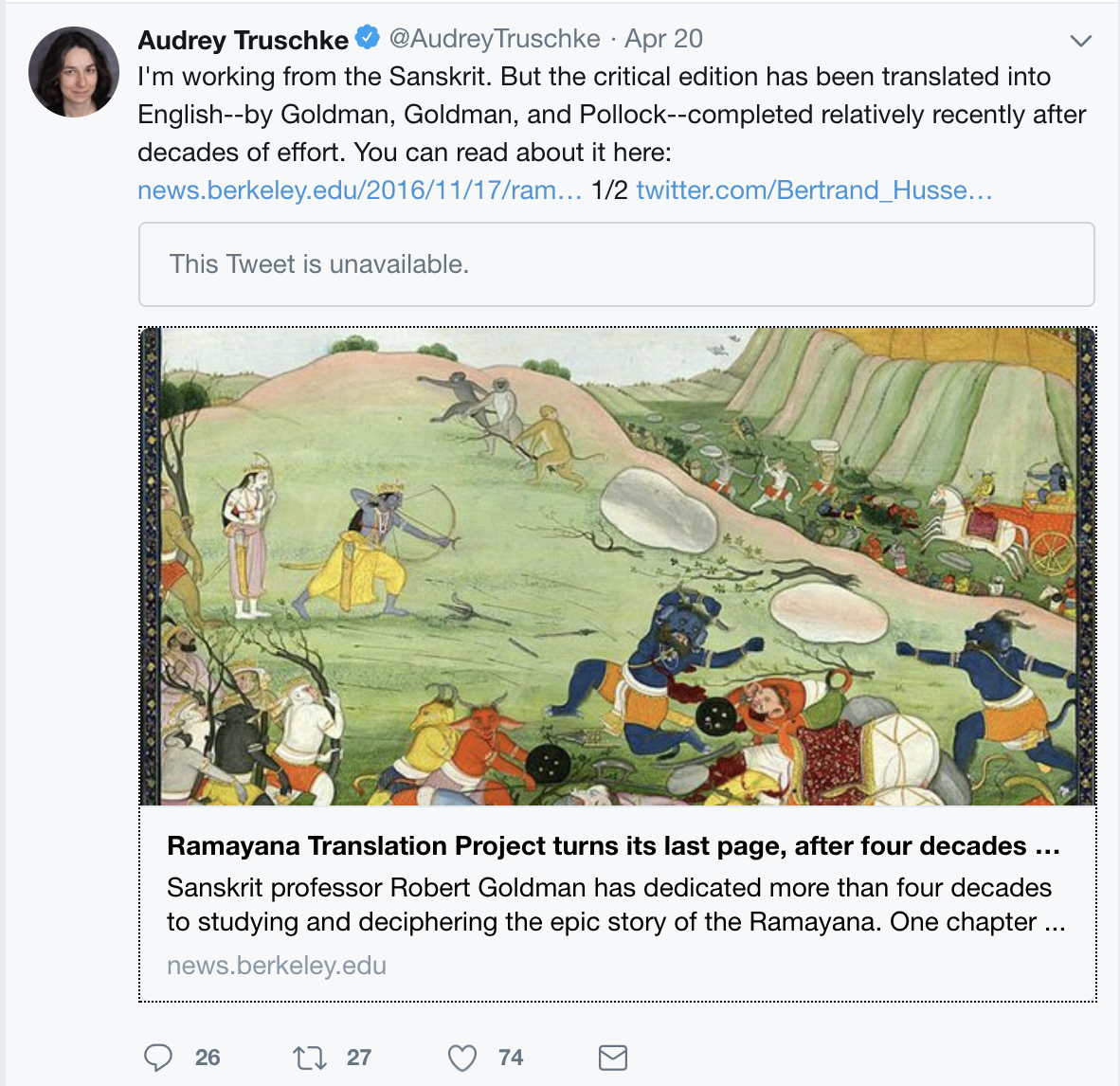
Rāma's (Non-Existent) Polygamy
Rāma had only one wife, and those who claim otherwise have obviously never even read the Rāmāyaṇa.
Rāma had only one wife, and those who claim otherwise have obviously never even read the Rāmāyaṇa.
T.M. Krishna’s admission of cowardly failure to support a sexual abuse victim explains his current and passionate support of the #MeToo movement. His support has lead him to blame “conservative” and “oppressive socio-cultural dogmas” for the prevalence of sexual abuse and apathy towards its prosecution, implying that Hindu culture is to blame. His comments reveal that he is oblivious to the fact that truly conservative Hindu ideals ensconced within mainstream Hindu literature are strongly averse to predatory sexual behavior. As such, he fails to appeal to our “Hinduness” as a strategy for dealing with predatory sexual behavior, thus missing an effective strategy for preventing and prosecuting sexual abuse. Therefore, we must lay blame for sexual abuse in India where blame is actually due – on the degeneration of conservative, Hindu values.
When it comes right down to it, anti-Hindu ideologues can not criticize Hinduism by telling the truth. So they just lie instead.
How a Rutgers University professor defended anti-Hindu prejudice, and learned the bitter taste of swallowing her own foot
A controversy erupted on Twitter recently when a Rutgers University Indologist claimed that Sītā criticized Rāma as a “misogynistic pig.”

The context that set this up began with two highly publicized rape cases in India in which the alleged perpetrators were nominally Hindu. In response to them, an Indian journalist published a cartoon caricature in which an imaginary Sītā tells an imaginary Rāma that she was glad to have been kidnapped by Rāvaṇa instead of one of Rāma’s devotees. The implication being that Rāma’s devotees (in other words, Hindus) are forgiving of rape or predisposed to committing the atrocious act:

This drew a predictable response from a member of the Hindu community who rightfully pointed out:
“There is nothing wrong in expressing her anger at Kathua incident and in fact, we, too, share her feelings,” said complainant Sagar, according to the Hindustan Times. “But where is the need to draw Hindu gods into the incident? How does it bring justice to the rape victims? Assuming that a Hindu had committed the crime somewhere in Kathua, how is it justified to blame millions of devotees of Lord Rama?”
Indeed.
What the complainant objected to was the characterization of an entire religious community with unfavorable attitudes based on the actions of a few.
In modern civil discourse, this is known as “prejudice.”
Yet, rather than acknowledging and addressing the prejudice, Audrey Truschke of Rutgers University instead tweeted in response to the cartoon controversy that Hindus had become averse to “criticism.” She then tweeted the above comments about Sītā criticizing Rāma, evidently to make the case that Hindus need to be more open-minded to the “criticism” that they are, as a class, favorably inclined towards rape. Because, evidently, in her mind, the acts of two individuals might somehow be representative of the attitudes of over 1 billion people who share the same religious background…
It hardly needs to be stated that Hinduism as a religious doctrine is highly intolerant of rape, and thus so its followers. The two main epics of Hinduism, the Mahābhārata and the Rāmāyaṇa, center around destructive wars that were started after a powerful villain mistreated a woman and then met with an untimely end as a result. Regarding the former, the author writes that the Kauravas, who had previously attempted to poison Bhīma, murder the Pāṇḍavas in fire, and usurp their wealth, had never sealed their destruction until they insulted Draupadī:
अथाब्रवीन्महाप्राज्ञो विदुरः सर्वधर्मवित् ।
एतदन्तास्तु भरता यद् वः कृष्णा सभां गता ॥ महा २.८१.२९ ॥
“It was then the greatly intelligent Vidura spoke thus. ‘This will prove the destruction of the Bharata race, namely the dragging of Kṛṣṇā (Draupadī) into the Sabha.’” (Mahābhārata 2.81.29) [translated by M.N. Dutt]
The Rāmāyaṇa also documents that Sītā would be the cause of Rāvaṇa’s death, referring to his abduction of her and subsequent destruction:
एषा वेदवती नाम पूर्वमासीत् कृते युगे ।
त्रेतायुगमनुप्राप्या वधार्थं तस्य रक्षसः ॥ वा.रा. ७.१७.४३ ॥
उत्पन्ना मैथिलकुले जनकस्य महात्मनः ।
सीतोत्पन्ना तु सीतेति मानुपैः पुनरुच्यते ॥ वा.रा. ७.१७.४४ ॥
“She who was known as Vedavatī in her former birth in Kṛtayuga, appeared again in the Tretāyuga as a daughter of the high-souled Janaka in the line of the kings of Mithila for bringing about the destruction of that Rākṣasa. Since she came out of a furrow (Sītā), she is called ‘Sītā’ by human beings.” (Vālmīki-Rāmāyaṇa 7.17.43-44) [translated by Gita Press]
It is hard to see how one can imply that Hinduism is forgiving of rape, when Hindu epics, cherished by even the common Hindu people, chronicled the downfall of powerful Kings due to their mistreatment of women.
Empiric data also fail to support the notion that Hindus are more accepting of rape than the average human being, contrary to the implied criticism of cartoonist/journalist Swathi Vadlamudi and her devoted defender from Rutgers University. United Nations data on the prevalence of rape, collected from 65 countries during the 2003-2010 time period, reveal that the United States has consistently had a 14 times higher incidence of per-capita rape cases than India, placing it at the #11 rank for police-recorded instances of rape compared to India’s position of #51. Of course, rape is always an atrocious act regardless of how frequently or infrequently it occurs, but the point remains that ascribing rape-friendly attitudes towards Indians cannot be rationalized based on objective evidence.
EDIT 4/27/2018: Since this writing, a user of a Saudi internet service provider edited the statistics on India’s rate prevalence, falsely increasing the per-capita incidence of rape for India from 1.8 (where it had consistently been for the past 7 years) to 109.8. Here is the evidence of the tampering:
The IP address of the user corresponds to that of someone using a Saudi internet service provider. Clearly, there is a politically-motivated (or perhaps religiously-motivated?) desire on the part of some unscrupulous parties to misrepresent the magnitude of India’s rape problem. As such, here is a source that cannot be edited, and which testifies to the point made above that India’s rape reporting is far lower than that of the United States, with about 1.8 cases per 100,000 population compared to America’s 27.3 cases, making for a nearly 15 times difference. Although rape reporting does not take into account under-reporting, which is a pervasive problem in every country regarding this crime, the fact remains that we have no objective reason to assume that India’s under-reporting is more or less than that of any other country. As such, we must be honest in reporting that the empirical data support the view that India remains near the low end of per-capita incidence of rape.
When neither the textual tradition nor criminal data can support an hypothesis of Hindu culture being forgiving or accepting of rape, one is left wondering why the two are linked in the minds of some left-wing Indian intellectuals. The only remaining possibility is prejudice, and it disturbs one to consider that the phenomenon of depicting Indians as lusty, beastly, and amoral creatures is disturbingly reminiscent of White colonialist prejudice, which continues to pervade the minds of left-wing Indian intellectuals of today with its toxic perceptions of Indian culture.
But such concerns are of no interest to Audrey Truschke, who “loosely translates” the Rāmāyaṇa as indicating that Sītā called Rāma a “misogynistic pig.” Because she allegedly said that, Hindus must be open to the possibility that deep down inside, they are really rapists at heart.
Except that Sītā never said that. She never said anything that even vaguely resembles that.
Let us consider the context of the Agni-Parikṣa incident in the Yuddha-Kāṇḍa of the Rāmāyaṇa to which Truschke refers. Rāvaṇa has just been defeated and Sītā, after nearly 10 months in captivity during which she was terrorized with constant threats of execution, is overjoyed at the thought of being reunited with her husband. But upon seeing her, and in complete contrast to the joyful expectations of the assembled devas and vānaras, Rāma feigns indifference to her and tells her that she may go wherever she likes.
किं मामसदृशं वाक्यमीदृशं श्रोत्रदारुणम् ।
रूक्षं श्रावयसे वीर प्राकृतः प्राकृतामिव ॥ वा.रा. ६.११६.५ ॥
“Why do You, like a common man, address to me, O hero, such unkind and unbecoming words, which are (so) jarring to the ear, as a common man would do to an ordinary woman?” (Vālmīki-Rāmāyaṇa 6.116.5) [translated by Gita Press]
Is it logical to assume that Sītā would address her husband as a valiant (vīra) one if she had thought Him to be a hater of women? When she is convinced that Rāma will not take her back, instead of accepting another husband as He had invited her to do (see 6.116.21-23), she orders Lakṣmaṇa to prepare a pyre, and prior to entering it, she circumambulates Rāma which is a traditional sign of respect to one’s Lord:
अधोमुखं स्थितं रामं ततः कृत्वा प्रदक्षिणम् ।
उपावर्तत वैदेही दीप्यमानं हुताशनम् ॥ वा.रा. ६.११६.२३ ॥
“Walking clockwise (as a mark of respect) about Śrī Rāma, standing with His head bent low, Sītā (a princess of the Videha territory) approached the blazing fire.” (Vālmīki-Rāmāyaṇa 6.116.23) [translated by Gita Press]
Then we see Sītā praying as follows:
यथा मे हृदयं नित्यं नापसर्पति राघवात् ।
तथा लोकस्य साक्षी मां सर्वतः पातु पावकः ॥ वा.रा. ६.११६.२५ ॥
“As my heart never turns away from Śrī Rāma, so may the god of fire, the witness of the world, protect me on all sides.” (Vālmīki-Rāmāyaṇa 6.116.25) [translated by Gita Press]
So just to be clear, Audrey Truschke, who claims to have summarized parts of the Rāmāyaṇa “accurately and in colloquial English,” believes that Sītā was doing pradakṣiṇam of, and declaring her eternal love for, a man she addressed as a hero but whom she actually thought of as a “misogynistic pig.”
It’s not even remotely sensible to hold to such an opinion, but Truschke doubled-down on her distorted reading of the text by alleging it to be “colloquial English” and proceeding with her agenda to address the question of “Why and how did Hindu stories become offensive to some modern Hindus?” The implication being that she knows Hindu stories better than Hindus do, thus creating her springboard for starting a debate on what she perceives as Hindu misogyny and rape culture.
Unfortunately, the issue here is that Hindus stories don’t offend Hindus. It is opportunistic and politically-motivated distortions of the stories which do.
As Truschke made it a point in her Twitter account to repeatedly endorse the English translation of Professor Robert Goldman:

…a member of the Hindu community reached out to Professor Goldman to get his opinion on Truschke’s “loose translation.” The subsequent email exchange with Professor Goldman was published on Swarajyamag.com and was, needless to say, less than flattering of Audrey Truschke’s “loose and colloquial” translation:
“Thanks for your message. I find it extremely disturbing but perhaps not unexpected to learn that AT (Audrey Trushcke) has used such inappropriate language and passed it off as coming from Valmiki. Neither the great poet nor we used anything like such a vulgar diction and certainly Sita would never have used such language to her husband even in the midst of emotional distress. Nowhere in our translation of the passage do we use words such as you mention AT as using.
When she refers to the “critical edition” she is referring to the Sanskrit text of the Ramayana as reconstructed by the scholars at the Oriental Institute of Baroda. We have, of course translated the whole text but she is in no way quoting our translation but giving her own reading of the passage in her own highly inappropriate language.
Sita is, of course distressed by Rama’s words when she is first reunited with him after her captivity. But her speech is dignified and moving. We have tried to capture her level of diction in our translation which nowhere uses either an anachronistic term like “misogynistic” or the utterly vulgar and wildly inappropriate term “pig”. Quite shocking, really. It seems as if she is superimposing her own feelings on the poetry of the Adikavi. It has nothing to do with our translation.”
Professor Goldman’s penultimate sentence hit the proverbial nail on the head. It was certainly not the case that Sītā thought of her Lord Rāma as a “misogynist.” Rather, it was Audrey Truschke, wanting desperately to lecture the heathen Hindus about morality and gender relations, who tried and failed miserably at co-opting the Rāmāyaṇa into her imaginary narrative of Hindu misogyny. Truschke of course, claims that she is all about the “middle ground,” which is to say cultivating knowledge and ignoring hate:

Well, this author attempted to counter her hateful assumptions about Hindu men with specific knowledge on Twitter, in particular the ślokas and arguments given above, always without making any threatening or obscene remarks. What was the result? You can see it below:

This writer is left with the impression that Truschke was never interested in engaging in civil debate with knowledgeable Hindus based on facts and evidence. Rather, she was trying all along to shock lay Hindus into a heated flame-war in which she could then cast herself as the victim trying to fight fanaticism and misogyny. Her deliberate attempts to provoke lay Indians in public, in a medium in which restraint would likely not be observed, all the while avoiding serious evidence-based discussion of the text with those capable of it, smack of disgusting, self-serving motives which are unbecoming of a scholar and of the institution that she represents.
You must be logged in to post a comment.